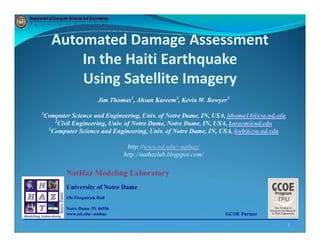
Automated Damage Assessment in the Haiti Earthquake using Satellite Imagery
- 1. Automated Damage Assessment g In the Haiti Earthquake Using Satellite Imagery Using Satellite Imagery Jim Thomas1, Ahsan Kareem2, Kevin W. Bowyer3 1 Computer Science and Engineering, Univ. of Notre Dame, IN, USA, jthoma14@cse.nd.edu 2 Civil Engineering, Univ. of Notre Dame, Notre Dame, IN, USA, kareem@nd.edu 3 Computer Science and Engineering, Univ. of Notre Dame, IN, USA, kwb@cse.nd.edu http://www.nd.edu/~nathaz/ http://nathazlab.blogspot.com/ NatHaz Modeling L b N H M d li Laboratory University of Notre Dame 156 Fitzpatrick Hall Notre Dame, IN 46556 www.nd.edu/~nathaz GCOE Partner 1
- 2. Introduction Automated damage detection from satellite or aerial imagery for post disaster analysis has been a major research effort in the past decade. Previous attempts mostly focused on pixel-based change detection (figure 1). A damage estimate is prepared using change detection on before-and- after event images. Such low-resolution analysis limits accuracy to a rough approximation of estimated damage. Figure 1 Th availability of hi h resolution i The il bilit f high l ti imagery provides an id opportunity for a more detailed analysis. However, building extraction in this approach is limited by color/shape variations in roof structures (figure 2). The Th ongoing research at U i i h t University of N t D it f Notre Dame focuses on detecting rooftops of all shapes and colors. This approach is geared towards the development of automated, accurate damage assessment techniques based individual buildings. b d on i di id l b ildi Figure 2 2
- 3. Building Extraction g A novel algorithm for building detection has been developed. This method makes use of supervised/unsupervised classification for initial segmentation. Figure 3 shows a pre-hurricane image from Pensacola, Florida. Buildings hidden by trees and the variations in roof structure make this a challenging example for building detection. Figure 3 g First step is a segmentation that classifies various pixels of the image into shadows, buildings, roads, vegetation etc.; See Figure 4. Different combinations of the classified segments are considered and a hypothesis tests whether the combination represents a building. Figure 4 This hypothesis makes use of shape, spectral and shadow evidence to accept or reject a group of segments as a building. The buildings thus extracted from the above image are marked in white in Figure 5 and have a detection accuracy of 91%. g y Figure 5 3
- 4. National Palace in Port au Prince, Haiti Port-au-Prince, (a) (b) Figure 6: g (a) National Palace before the quake; (b) buildings extracted from image in (a). Figure 7: (a) National Palace after the quake; (b) buildings extracted from image in (a). (a) (b) 4
- 5. Change Detection Color-histogram-based change measures were computed as follows: HSV color space histograms were computed for the before and after images. The Bhattacharyya distance d(H1,H2) between yy ( , normalized histograms H1 and H2 is given by: This distance represents the change from before to after the earthquake. A false color damage map based on the Lesser More computed distance is shown in Figure 8. damage damage Figure 8 5
- 6. Change Detection ( g (Contd.) ) Edge density is another measure, that captures non-uniformity of texture resulting from damage. More edges are likely to appear in an after-event image as a result damaged or collapsed roofs d d ll d f A difference image of the National palace is shown in Figure 9 and the corresponding edges detected using the Canny edge detector are shown in Figure 10. Figure 9 Figure 10 6
- 7. Results Plots of damage measures computed vs actual damage states (ground truth) for color histogram distances (a) and edge density measures (b) are shown below. While color-histogram based measures discriminate well between collapsed and undamaged roofs, edge-density measures are particularly useful in identifying collapsed rooftops. 1.2 1.2 0.4 0.4 0.35 0.35 1 1 0.3 0.3 0.8 0.8 0.25 0.25 0.6 0.6 0.2 0.2 0.15 0.15 0.4 0.4 0.1 0.1 0.2 0.2 0.05 0 05 0.05 0 05 0 0 0 0 Collapsed Partial Damage No Damage Collapsed Partial Damage No Damage ( ) (a) Color Histogram distances g ( ) (b) Edge-density measures g y 7
- 8. Acknowledgment The support for this study was provided by the Collaborative Research Program at the NatHaz Laboratory as a part of the Global Center of Excellence at the Tokyo Polytechnic University: New Frontier of Education and Research in Wind Engineering. The funds were provided by the Ministry of Education, Culture, Sports, Science and Technology (MEXT), Japan. The opinions presented in this report do not necessarily reflect the views of the collaborators or the funding agency. 8